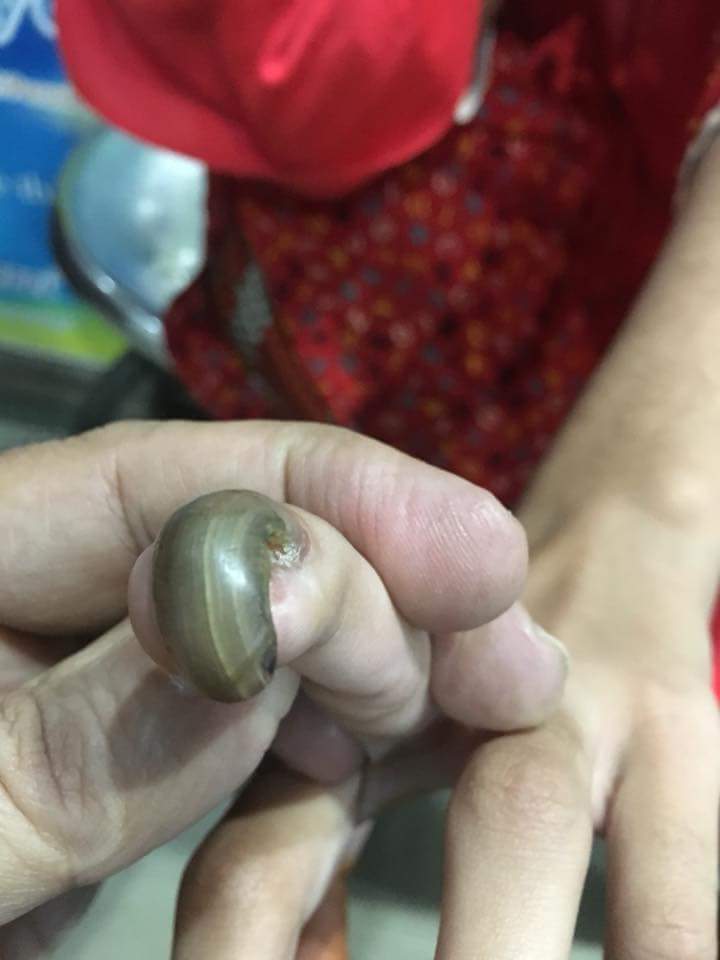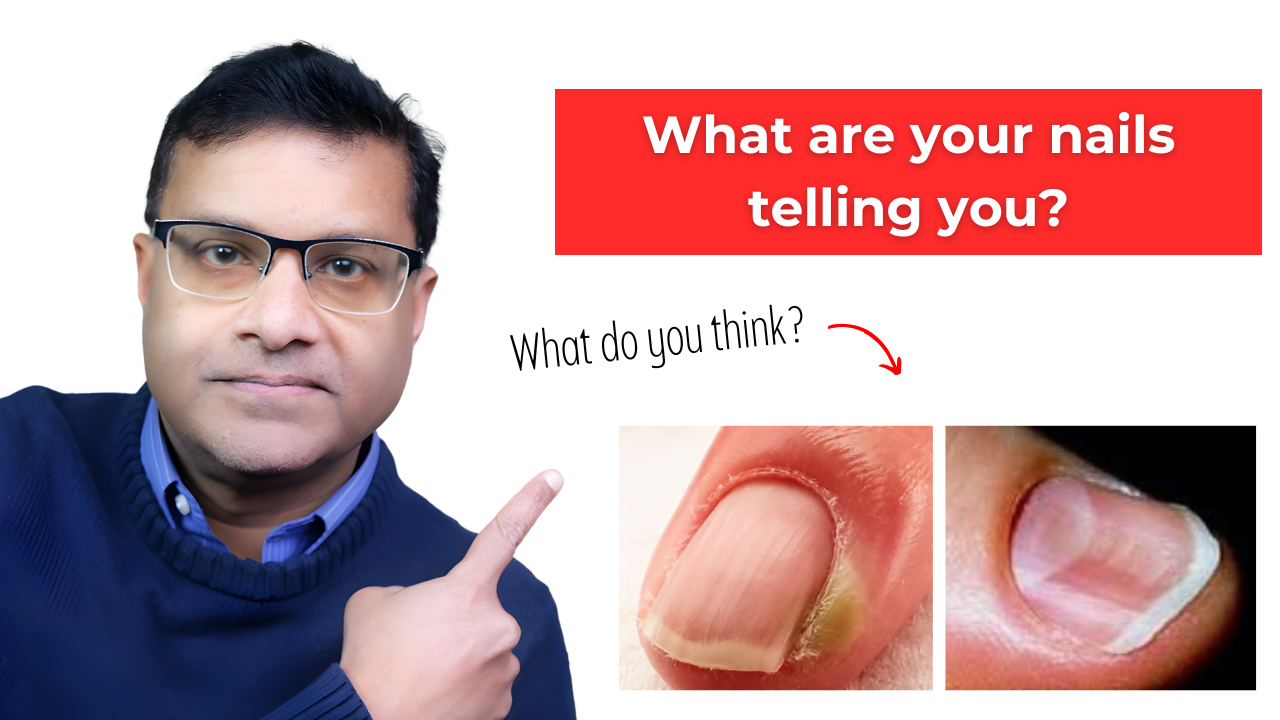This article will examine all kinds of nail abnormalities Everything from white spots, yellow nails to nail clubbing will be looked at.
1)White Spots (Leukonychia):
The most common cause of white spots on nails is minor trauma to the nail matrix, the tissue under the nail that produces cells that become the nail plate. This kind of trauma can occur from everyday activities such as tapping your nails against a keyboard or counter, slamming a door, or tight-fitting shoes causing repeated pressure on the toenails.
Another cause can be an allergic reaction to nail polish, hardeners, or nail polish removers that contain harsh chemicals. The reaction can damage the nail matrix, leading to the appearance of white spots.
In some cases, the presence of white spots can be attributed to infections, particularly fungal infections, which can affect the underlying nail bed and disrupt nail production subtly enough to cause discoloration.
While white spots are typically harmless and usually related to physical trauma, persistent spots could indicate a more significant health issue.

1)Nutritional Deficiencies: Deficiencies in zinc, calcium, or even protein can manifest as white spots on the nails. Ensuring a balanced diet can help resolve nutrient-related nail issues.
2)Systemic Health Issues: Less commonly, white spots can indicate systemic health problems. Conditions such as hypoalbuminemia, a symptom of kidney and liver diseases where there is a low level of albumin in the blood, can cause widespread leukonychia.
2.Yellow Nails:
Let’s look at possible 4 causes.
- Frequent Use of Nail Polish: One of the most common causes of yellow nails is the frequent application of dark-colored nail polishes without a protective base coat. The pigments used in these polishes can stain the nails, especially when nails are not given time to rest between polish applications.
- Fungal Infections: A fungal infection is a frequent medical reason for nails turning yellow. The fungi involved typically affect the nail bed and nail plate, leading to changes in color, thickness, and texture. These infections are more common in toenails due to the warm, moist environments often created by shoes.
- Smoking: Nicotine and tar in cigarettes can stain nails and surrounding skin, leading to a yellowish tinge over time. This is often more pronounced in heavy smokers.
- Medical Conditions: Yellow nails can also indicate more serious health problems. For instance, yellow nail syndrome is a rare condition characterized not just by nail discoloration but also by lymphedema (swelling related to lymph circulation) and respiratory issues. Other possible health conditions linked to yellow nails include chronic bronchitis, jaundice due to liver dysfunction.
3.Brittle Nails (Onychorrhexis):
Are your nails cracking, splitting or breaking? Do you have this problem? You might be dealing with brittle nails. Here on the side are a list of some of the causes:
1.Environmental Exposure: If your nails are repeatedly exposed to harsh chemicals such as cleaning agents or you are exposed to dry weather conditions, this can strip moisture from the nails, making them more fragile!
- Nutritional Deficiencies: Insufficient intake of vitamins and minerals can affect nail health. For example, lack of biotin, iron, vitamin C, or zinc can lead to weakened nail structure.
- Aging: Nails naturally become more brittle with age due to reduced blood circulation and slower cell turnover.
- Overuse of Nail Products: Frequent use of nail polish removers, particularly those containing acetone, and excessive use of gel or acrylic nails can weaken the natural nails over time.
- Health Conditions: Brittle nails can also be a symptom of underlying health issues. Conditions like hypothyroidism, Raynaud’s syndrome, or lung conditions can manifest symptoms in the nails.
4.Pitting:
What if you have tiny pits in your nails. This is often linked with psoriasis. Approximately 50% of persons with psoriasis will experience nail changes, including pitting, at some point in their lives. While nail pitting itself might not cause discomfort, its presence is often a sign of systemic or skin-specific autoimmune disorders. Other conditions which might be linked to pitting nails are Eczema and alopecia areata. Eczema is a skin condition that can extend its effects to the nails. An autoimmune disorder called alopecia areata. In this condition you start losing patches of hair and it can also affect nails
5.Clubbing:
Nail clubbing, also known simply as clubbing, is characterized by the softening of the nail bed. Because the nail bed is softer there is a subsequent curving of the nails. One sees also an enlargement of the fingertips. Clubbing is usually a gradual process and may take years to become fully apparent.
Causes of Nail Clubbing
Nail clubbing can be caused by a variety of conditions, primarily those that decrease oxygen levels in the blood or involve the lungs and heart. I have listed the most common causes here
- Lung Diseases: Conditions like lung cancer, interstitial lung disease, cystic fibrosis, and emphysema are common causes of clubbing.
- Heart Diseases: Certain heart diseases that lead to low oxygen levels in the blood, such as congenital heart defects and infective endocarditis, can result in clubbing.
- Gastrointestinal Diseases: Clubbing can also be associated with diseases of the digestive tract, including Crohn’s disease and ulcerative colitis.
- Other Causes: Less commonly, clubbing can be linked to liver cirrhosis, thyroid disorders (particularly hyperthyroidism), and other systemic infections or diseases.
6.Beau’s Lines:
Beau’s Lines are distinct depressions that can appear horizontally across the fingernails or toenails. They can occur in one or more nails. So in other words these lines are not superficial marks; What they represent a temporary interruption in nail growth. Your body is indirectly telling you this is a serious health condition. Pay attention. due to various underlying health conditions or physical trauma.
Common causes include:
- Systemic Illnesses: Any severe illness that affects the entire body can lead to Beau’s Lines. Examples include severe infections such as pneumonia or malaria, major surgery, or any serious metabolic condition, including uncontrolled diabetes.
- Nutritional Deficiencies: Lacking essential nutrients like proteins, zinc, or vitamins, particularly Vitamin B, can impair nail growth and lead to Beau’s Lines.
- Trauma: Physical damage to the nails, such as injuries from accidents or repetitive trauma from nail-biting or picking, can also cause these lines.
- Chemotherapy: Certain chemotherapy drugs can halt the growth of nail cells temporarily, causing Beau’s Lines to form.
- Exposure to Cold Temperatures: In some cases, prolonged exposure to cold can reduce blood flow to the nail matrix, affecting nail growth and causing lines to form.
- Nail Bed Infections: Fungal infections or other infections affecting the nail bed can disrupt nail growth.
7.Spoon Nails (Koilonychia):
Spoon nails as the name states makes your nails like spoons. This is because your nail thins, and your nail plate curves upwards -makes it look like a spoon. In fact sometimes it could be large enough to hold a drop of water. This condition can make the nails fragile and prone to splitting. Usually it affects your finger nails, but it can affect your toe nails.
Causes of Spoon Nails
- Iron Deficiency Anemia: This is the most common cause of spoon nails. Iron deficiency leads to low levels of hemoglobin in the blood, which affects the body’s ability to transport oxygen efficiently. The resulting poor circulation can impair nail growth and health.
- Hemochromatosis: This is a distinct disease…Just means your body is overloaded with iron and affect various organs including your nails.
- Raynaud’s Disease: This condition, which causes small blood vessels to narrow in response to cold or stress, can lead to spoon nails due to reduced blood flow to the extremities.
- Fungal Infections: Nail fungal infections can alter the shape of the nails, sometimes leading to spooning.
- Trauma: Repeated trauma or injury to the nail bed can cause the nails to grow abnormally, potentially resulting in koilonychia.
- Exposure to Chemicals: Prolonged exposure to petroleum-based solvents can weaken and damage the nails, contributing to the development of spoon nails.
8.Terry’s Nails:
This is when the nail bed changes color, becoming mostly opaque white, while the tip features a narrow pink or reddish band. See the picture here. The condition affects all or most of the nails and is more common in older adults. You might ask why is it called Terry’s nails. Well it was first described by Dr. Richard Terry in patients with severe liver disease, but subsequent research has shown it can be associated with a broader range of health issues.
What disease are associated with this description?
- Liver Disease: I mentioned this earlier.Originally linked to cirrhosis, Terry’s nails can appear in various stages of liver disease.
- Kidney Failure: Chronic kidney disease and renal failure can also manifest Terry’s nails, indicating severe impairment in kidney function.
- Heart Failure: Congestive heart failure is another significant condition associated with Terry’s nails, where reduced cardiac output affects blood circulation, influencing nail health.
- Diabetes: In diabetic patients, Terry’s nails may indicate vascular complications or other systemic effects of the disease.
9.Dark Stripes (Subungual Melanoma):
Here you need to pay attention. This is a serious sign. This could be a form of skin cancer called subungual melanoma. Dark stripes on the nails can appear as longitudinal bands ranging from brown to black. While they can be benign and common in individuals with darker skin tones. This is due to more active melanocytes in the nail matrix. So, if you see any new, changing, or singular dark stripe you should talk to your healthcare provider.
10.Onycholysis:
Onycholysis is a nail condition characterized by the separation of the nail from the nail bed and starts to peel upwards. Usually this is not painful.
Causes of Onycholysis. Here on the side I have listed the most common causes especially fungal infection and traumatic injuries. Fungal infections can cause a nail separation and physical injuries even such as aggressive manicuring or typing can be causes.
- Trauma: Physical injury such as aggressive manicuring, typing, or catching the nail on an object can cause the nail to lift away from its bed.
- Infection: Fungal infections are common causes of nail separation. Yeast and bacteria can also infect the nail, especially in an environment conducive to growth such as moisture and warmth.
- Skin Diseases: Conditions such as psoriasis, eczema, and lichen planus can involve the nails and lead to onycholysis.
- Allergic Reactions: Allergic reactions to nail care products like nail polish, hardeners, or nail polish removers can cause onycholysis.
- Systemic Conditions: Disorders like thyroid disease, particularly hyperthyroidism, can cause nails to become loose. Other systemic conditions, such as iron deficiency anemia, can also lead to onycholysis.
Drug Reactions: Certain medications, including tetracyclines and fluoroquinolones, can increase sensitivity to sunlight, leading to photo-onycholysis, where the nail detaches after exposure to UV light.
11.Onychogryphosis ( Rams horn nails)
This is a nail disease characterized by a significant thickening and curvature of the nails that resemble a ram’s horn. The nails can become so deformed that they lose their regular shape and direction, growing thicker and in a curved, claw-like fashion. Usually you see this condition in older adults with reduced mobility. Here on the side are the most common causes especially lack of hygenie and mobility.This is the perfect climate for a fungal infection.
- Trauma: Repeated trauma or injury to the nail or toe, often from ill-fitting shoes, is a common cause. Each injury can exacerbate the nail’s growth abnormality.
- Neglect: Lack of proper foot care, especially in the elderly or immobile, can lead to abnormal nail growth patterns.
- Infection: Fungal infections can cause thickening and abnormal growth of the nails.
- Skin Conditions: Psoriasis and other skin conditions that affect the nail bed and matrix can lead to onychogryphosis.
- Poor Circulation: Conditions that affect blood flow, such as diabetes and peripheral arterial disease, can contribute to abnormal nail growth.
12.Paronychia
Paronychia is a common nail infection that affects the skin around the nail, usually the skin at the base or the sides of the nail. It results in painful, red, and swollen skin, and can sometimes produce a pus-filled blister. What can cause this?
Causes of Paronychia
- Bacterial Infection: Most acute cases of paronychia are caused by bacteria, commonly Staphylococcus aureus.
- Fungal Infection: Chronic paronychia is often caused by a fungal infection, particularly Candida yeast. This can be due to prolonged exposure to moisture, making this condition common among dishwashers, cleaners, and people who frequently have wet hands.
- Yeast and Viral Infections: Besides bacteria and fungi, yeast and certain viruses can also cause paronychia, especially in individuals with weakened immune systems.
SOURCES:
Liscence https://creativecommons.org/licenses/by-sa/4.0/deed.en
White spots: https://commons.wikimedia.org/
Yellow nails https://www.freemalaysiatoday.com/
Brittle nails: https://www.flickr.com/
Nail pitting: https://universe.roboflow.com
Nail clubbing: https://commons.wikimedia.org
Beau’s lines: https://commons.wikimedia.org
Spoon’s nails: https://www.healthline.com/health/spoon-nails-koilonychia
Terry’s nails: https://en.wikipedia.org/wiki/Terry%27s_nails, https://en.wikipedia.org/wiki/T
Dark stripes on nails: https://www.menshealth.com/health/a19536159/nail-melanoma-symptoms/
Onycholysis: https://en.wikipedia.org/wiki/Onycholysis
Ram’s horn nails: https://universe.roboflow.com
Paronychia: https://commons.wikimedia.org/wiki/
If you are interested in other videos, click right here




